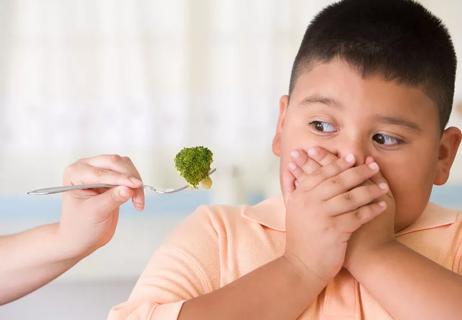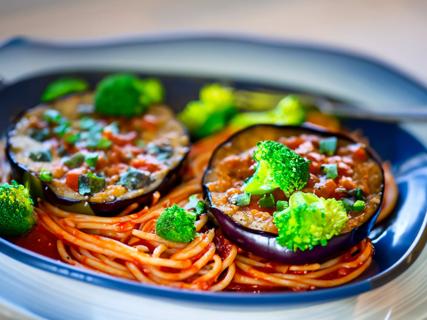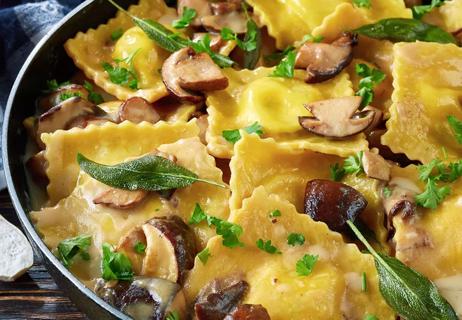Turn down the pressure, but don't stop offering

You’ve set the table for dinner and are feeling super proud of the share-worthy rainbow array of healthy foods you’ve seasoned to perfection. (Or reality: Maybe it’s Monday and you managed to steam some broccoli. Still a commendable showing.)
Advertisement
Cleveland Clinic is a non-profit academic medical center. Advertising on our site helps support our mission. We do not endorse non-Cleveland Clinic products or services. Policy
But in walks the toddler. And you know how dinnertime is about to unfold.
There will be pleading: “Please, just try your vegetables.”
Then, demanding: “You’re not leaving this table until you eat your broccoli.”
And finally, bribing: “Try it, and you can have a cookie.”
And the vegetables? Still sitting in the bowl.
Not so smug now, huh?
But it doesn’t have to be so hard — for you or your picky eater.
“It’s natural that young kids might not be eager to try new foods,” says pediatric dietitian Diana Schnee, RD, LD. “Kids’ lives are full of new routines, new things to learn, new friends to play with. Sometimes, new vegetables can be just one thing too much.”
Even still, you want your kiddo to get their dose of vitamins and minerals that you know come from fresh produce. It’s important for their development after all, and part of building a healthy relationship with food. So Schnee offers up some tried-and-true tips and hacks for getting your kids to eat their veggies.
Schnee says a good rule of thumb is that produce (aka fruits and vegetables) should take up half your plate. That’s true for kids and grownups alike.
“In an ideal scenario, families would incorporate fresh produce in every meal, although that might not always be realistic,” Schnee says. “That’s where snack times can fit in. Or double up on veggies at dinner or wherever you can to get those extra servings in.”
Advertisement
But … how? Schnee lays out these tips to help get your little one the fresh foods their growing bodies need.
If your tot would rather feast on nuggets than nibble on green beans, you’re not alone. A recent report from the U.S. Centers for Disease Control and Prevention (CDC) says half of kids in the U.S. didn’t eat vegetables each day.
The U.S. Department of Agriculture’s recommendations for kids and veggies suggests the following amounts of vegetables each day:
For context, a cup of vegetables translates roughly to two medium carrots, one large sweet potato or two stalks of celery.
Now that you know how many veggies your kiddo should be eating, you may be feeling extra motivated to push the greens like a used car salesperson looking for a big commission.
Instead, breathe. You don’t want to get in a battle of wills with a little kid. You probably won’t win.
Schnee says, when it comes to mealtimes, adults and kids each has choices to make and roles to take on. Parents and other caregivers should be the ones making decisions on what to eat, when to eat and where to eat. Kids, on the other hand, choose whether they eat.
Schnee suggests offering up veggies on the daily. But don’t insist, bribe or punish.
“Anything we can do to make the child more familiar with a food is the best thing to do,” Schnee reassures. “Offering vegetables consistently is a win. Encourage your child to touch the food, smell it, or describe its color or texture. Those are all really positive interactions with food — even if they don’t put it in their mouth.”
The point is that encouraging kids to use their other senses to learn about foods takes the mystery away. By the time they see butternut squash for the 20th time, it’s lost its allure. Your kid will know what it is, what it smells like, what it feels like, what color it is. It’s not new or special or scary anymore. The only thing left to do is try it. When they’re ready.
The best veggies for your child will depend on a lot of factors, like their age and their preferences for certain textures or tastes. But in general, you’ll want to focus on foods that are healthy and present a low risk for choking. That means soft and cooked veggies may be some of the best choices for younger kids.
Advertisement
Some child-friendly options may include:
We know that vegetables are full of nutrients that fuel our bodies. But your kid probably doesn’t appreciate the difference between the immune-boosting effects of spinach and the empty calories of chips and sweets.
Explaining healthy eating to kids can help them understand where you’re coming from and why cookies aren’t a main course. But keep it in words they’ll understand.
“After your child eats a bowl of pasta and then begs for dessert, you can try saying something like, ‘Remember, we want to eat a balanced meal. Pasta gives us really good energy. Now, we need to focus on some food that’s going to help make your belly feel good,’ or ‘food that’s going to make your muscles strong,’” Schnee suggests.
The internet is full of innovative little gadgets that can make mealtimes more entertaining for kids. There are chopstick-like contraptions that feature dinosaurs and unicorns. Toothpicks with animal figures on them. Tongs that look like tiny hands. Teeny cookie cutters for making cucumber slices into hearts and stars. You get the picture.
If your budget allows, Schnee suggests trying some of those little gizmos to kick up the cute factor and make eating vegetables feel more enticing.
Advertisement
You may have seen recipes on social media or heard from a friend about hacks to hide veggies in your child’s favorite foods. Puree some squash into their mac and cheese. Mash some broccoli into their quesadilla. (“They’ll never know the difference!”) It’s tempting, right?
But Schnee says that’s not a long-term solution. And it could really backfire.
“Kids are smart. They’re going to notice if you change up a food they like, and that creates distrust,” Schnee explains. Worse, that could put them off of foods that had once been an easy go-to.
Sure, those measures will get some veggies into their system, but it doesn’t teach your child to try new foods or appreciate veggies on their own. It’s a bandage, not a solution.
“I’d rather have them learn to try and appreciate fruits and vegetables without trying to hide things,” Schnee advises.
Starting in the toddler years, kids want to do what you do. It’s a natural part of child development. Getting them involved in choosing foods and preparing them serves two purposes.
For starters, it allows them to be part of grown-up stuff, which they crave. And it also gives them a chance to have a new interaction with veggies and other foods they haven’t become familiar with.
Advertisement
When they feel some responsibility and involvement with food, it may make them more interested in giving it a taste.
When you say things like, “Junior doesn’t eat asparagus,” it becomes a self-fulfilling prophecy. You made up your mind they don’t like it, so you stop serving it. The result: They don’t get familiar with asparagus. And when you come back around to serving it again, they don’t want to eat it. And your original conclusion is confirmed. Junior didn’t eat the asparagus. But it’s because they weren’t familiar with it. Not necessarily because they don’t like it.
“As parents, we can get in the habit of saying, ‘My kid doesn’t like X, Y or Z,’” Schnee says. “But what that does is provide a crutch for our child. We wind up limiting them by labeling them.”
Instead, remember that kids change and grow. All. The. Time. One day, they’re super into drawing. The next, they’re all about building that giant tower of blocks. Their interests change, and so do their tastes in food.
You wouldn’t throw out all their crayons if they choose not to color one day. So, why not keep the options open when it comes to foods they eat, too?
Plain veggies may sound just fine to you, but your child may prefer something with a little more pizzazz.
Spreading peanut butter on celery may be more appealing than munching on a stalk straight up. Or dunking some carrots in hummus can make for fun times with food.
Likewise, sprinkling some seasonings on veggies, like ranch seasoning, oregano, or other favorite flavors could up the ante and spark some interest.
As you’re working to increase the veggies in your kid’s life, you may think about trying a children’s multivitamin in the meantime. Schnee says you should always talk with your children’s healthcare provider, like a pediatrician or registered dietitian before starting a supplement. But multivitamins can be a useful option for some kids.
“Multivitamins can be a really good insurance policy for kids that aren’t eating their fruits and vegetables,” Schnee says. “But eating a balanced diet is always going to be more effective for their nutrition.”
If you go the route of a children’s multivitamin, look for one that is age appropriate and has the wording “NSF certified” on the label. That means they’ve been tested by an independent third party.
At the end of the day, know you’re doing your best. And that’s all anyone can ask.
“Refusing veggies and other foods is often just a natural evolution of kids exploring their world and figuring out what they can say yes and no to. That’s a normal part of children’s development,” Schnee explains. “All we can do is set them up for success and continue to offer things. Chances are, if you’re concerned about it and trying to find a solution, you’re doing an amazing job.”
Learn more about our editorial process.
Advertisement

From routines to portion sizes, these strategies can help your child eat a broad range of food

It might be an eating disorder called ARFID

A delicious twist on this classic dish

A creamy and satisfying side dish

Lettuce is a versatile vegetable loaded with antioxidants and good-for-you nutrients

When it comes to getting proper nutrition, your assigned sex can play a role — but there’s more to it than that

This unique-looking veggie is fiber-dense and antioxidant-rich, and can improve the health of your gut, liver and heart

A satisfying and savory meal sure to impress family and friends

Type 2 diabetes isn’t inevitable with these dietary changes

Applying a hot or cold compress can help with pain